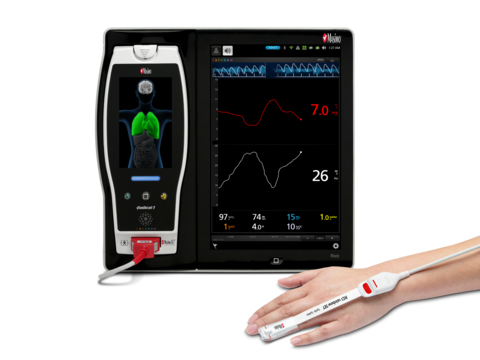NEUCHATEL, Switzerland– Masimo (NASDAQ: MASI) today announced the findings of a prospective study published in the Egyptian Journal of Anesthesia in which Dr. Mohamed Ibrahim Beleta and colleagues at Cairo University evaluated the accuracy of noninvasive, continuous hemoglobin monitoring with Masimo SpHb® on patients undergoing elective cesearan section (CS) with antepartum hemorrhage. The researchers found significant positive correlations between SpHb and invasive hemoglobin (Hb) values, and concluded, “In patients undergoing CS with antepartum hemorrhage, continuous SpHb through Masimo Pulse CO-Oximetry demonstrated clinically acceptable accuracy of Hb measurement compared with invasive Hb, even at low hemoglobin levels.”1
The authors note that antepartum hemorrhage is associated with adverse maternal and neonatal outcomes and that blood transfusion is also associated with a variety of risks, but that invasive laboratory hemoglobin measurement, while a crucial factor in transfusion decisions, yields intermittent and often delayed results. The researchers thus sought to evaluate whether use of noninvasive, continuous hemoglobin monitoring might “enable a more rapid detection of clinically significant blood loss, improve perioperative transfusion practices, allow patient condition to be assessed more quickly and blood management more adequately, and perhaps even reduce needless transfusions.” They enrolled 60 pregnant women, aged 18-45, scheduled for elective CS under general anesthesia between April 2016 and December 2017. All subjects had antepartum hemorrhage and were candidates for blood transfusion. During the procedure, all patients were monitored as per hospital standards, and in addition, with Masimo SpHb. All blood samples (Lab Hb) were analyzed using the same Coulter laboratory analyzer to avoid variance induced by the use of multiple devices. Lab Hb and SpHb values were recorded before induction of anesthesia (baseline), before transfusion, and after transfusion. Blood transfusion was carried out when Lab Hb decreased by more than 20% from baseline.
The researchers found significant positive correlations between SpHb and invasive Hb at the three points of comparison: baseline (r = 0.946), pre-transfusion (r = 0.902), and post-transfusion (r = 0.698). Differences at those times were insignificant: p = 0.196, p = 0.092, and p = 0.570, respectively. Using Bland-Altman analysis, they found low bias and moderate limits of agreement: 0.348 g/dL (-0.584 and 1.280) at baseline measurement, 0.314 g/dL (-0.561 and 1.188) at pre-transfusion, and 0.348 g/dL (-0.584 and 1.280) at post-transfusion.
The investigators concluded, “Continuous SpHb Masimo Pulse CO-Oximetry shows an appropriate clinically reliable Hb calculation in comparison to Invasive Hb even in patients undergoing CS with low hemoglobin. Further studies are needed on larger sample size with multicenter collaboration. Furthermore, we recommend the assessment of this technique on patients with common morbidities, such as high cholesterol, high blood pressure, and diabetes.”
The researchers also noted that “SpHb evaluation has the potential for additional benefits, including patient comfort, increased safety, and decreased complexity for healthcare staff, who are not exposed to the risks of needle-stick injury and bloodspill contamination.”
SpHb is not intended to replace laboratory blood testing. Clinical decisions regarding red blood cell transfusions should be based on the clinician’s judgment considering, among other factors, patient condition, continuous SpHb monitoring, and laboratory diagnostic tests using blood samples.


